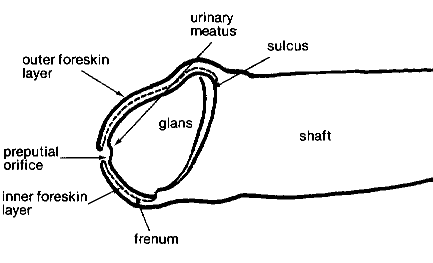
- Urinary
- Meatus
- Outer Foreskin - Sulcus I
- Inner Foreskin
- Layer
- Frenum
The American Academy of Pediatrics, Elk Grove Village, IL, 1999.
At birth, a boy's penis, including the shaft and head (glans), is covered by a double fold of skin. This is called the foreskin. Circumcision removes the foreskin over the glans. If a boy is not circumcised, his foreskin is left intact. During the first several years of life, the intact foreskin will naturally separate from the glans. This is called foreskin retraction. This information has been developed by the American Academy of Pediatrics to explain foreskin retraction, smegma, and how to care for the uncircumcised penis.
Foreskin retraction occurs when the foreskin can be pulled away from the glans toward the abdomen. This process happens on its own. When it happens is different for every child. Most boys will be able to retract their foreskins by the time that they are 18 years old.
When the foreskin separates from the glans, skin cells are shed. This begins in childhood and continues through the teen years. New skin cells regularly replace the ones that are shed. Since this shedding takes place in a closed space - with the foreskin covering the glans - the shed skin cells may look like whitish lumps, resembling pearls, under the foreskin. These whitish lumps are called smegma. Specialized glands, called Tyson's Glands, located under the foreskin are largely inactive in childhood. At puberty, Tyson's Glands produce an oily substance, which when mixed with skin cells, make up adult smegma. Adult smegma serves as a protective lubricator for the glans.

Drawing reprinted by permission of Edward Wallerstein.
The uncircumcised penis is easy to keep clean. When your son is an infant, bathe or sponge him frequently and wash all body parts, including the genitals. You do not need to do any special cleansing, such as with cotton swabs or antiseptics. Simply wash the head of the penis and the inside fold of the foreskin with soap and warm water. Remember, do not try to forcibly retract the foreskin. You should watch your baby urinate to be sure that the hole in the foreskin is large enough to allow a normal stream. Consult your pediatrician if:
If the foreskin becomes inflamed, a common cause is the fungus monilia, which can cause redness and itching. This can be easily treated with antifungal cream. If the foreskin becomes considerably red or swollen, see your pediatrician. If your son's foreskin is fully retracted before puberty, an occasional retraction with cleasing beneath will do. Once your son starts puberty, he should retract the foreskin and clean beneath it on a daily basis. It should become a part of your son's total body hygiene, just like shampooing his hair and brushing his teeth. Teach your son to clean his foreskin by:
Caring for your son's uncircumcised penis requires no special action. Remember, foreskin retraction will occur naturally and should never be forced. Once boys begin to bathe themselves, they will need to wash their penis just as they do any other body part.
This information should not be used as a substitute for the medical care and advice of your pediatician. There may be variations in treatment that your pediatrician may recommend based on individual facts and circumstances.
The Circumcision Information and Resource Pages are a not-for-profit educational resource and library. IntactiWiki hosts this website but is not responsible for the content of this site. CIRP makes documents available without charge, for informational purposes only. The contents of this site are not intended to replace the professional medical or legal advice of a licensed practitioner.
© CIRP.org 1996-2025 | Filetree | Please visit our sponsor and host:
IntactiWiki.